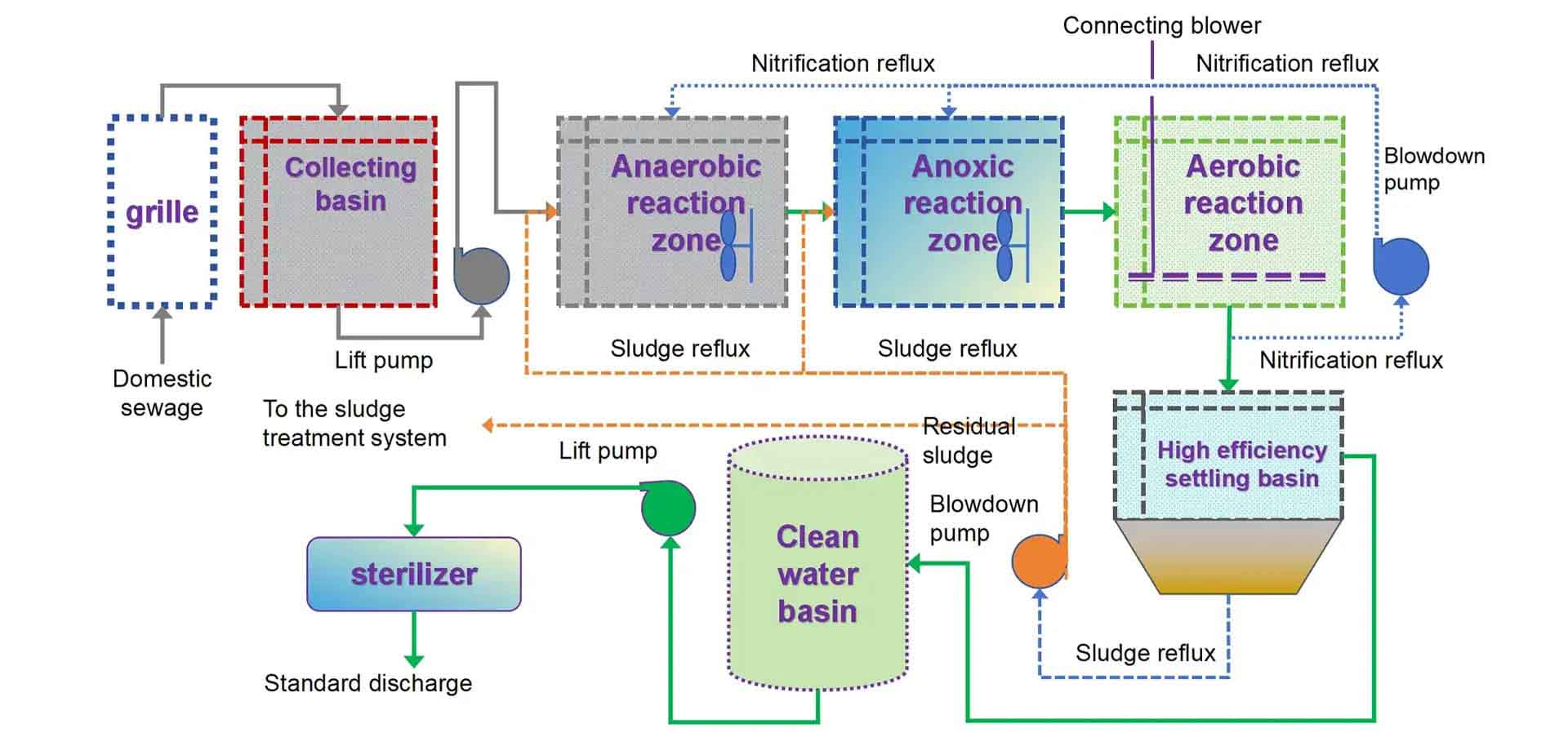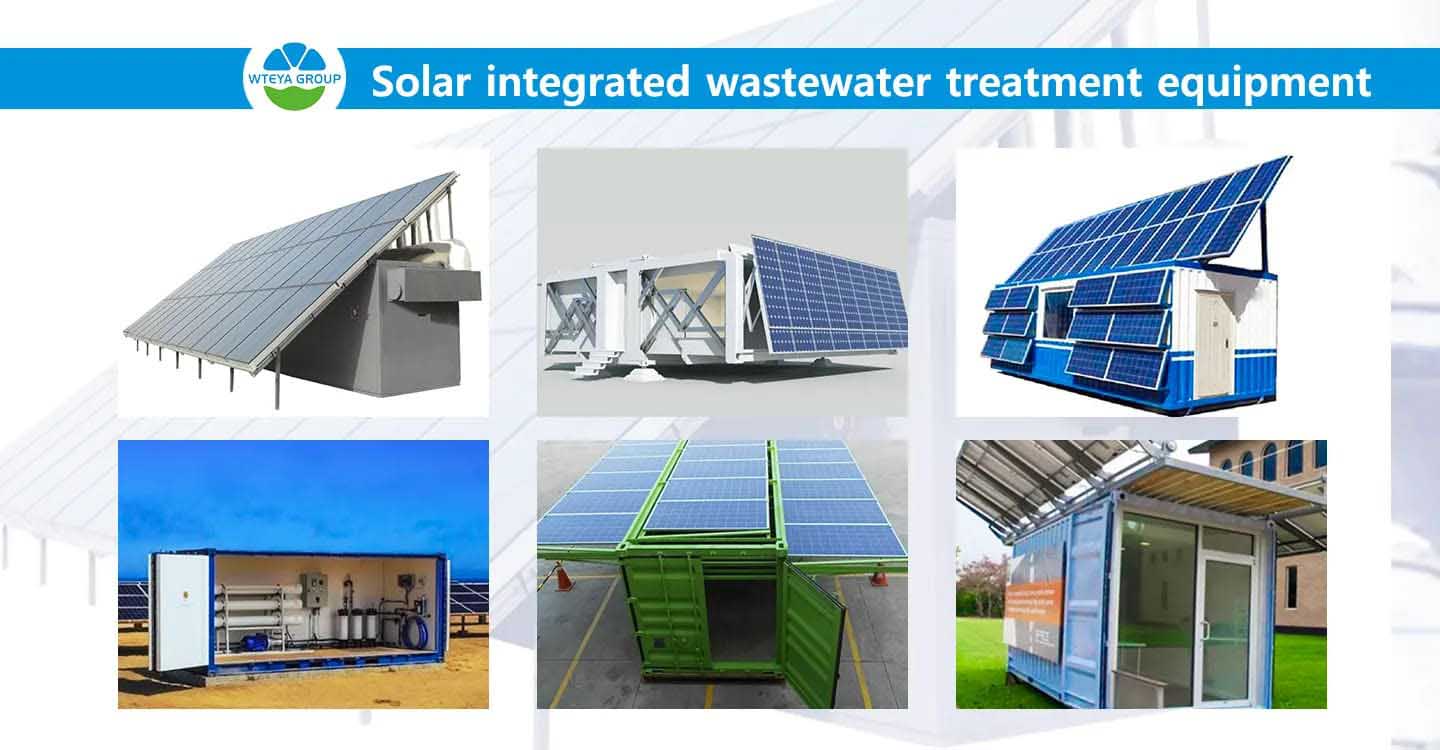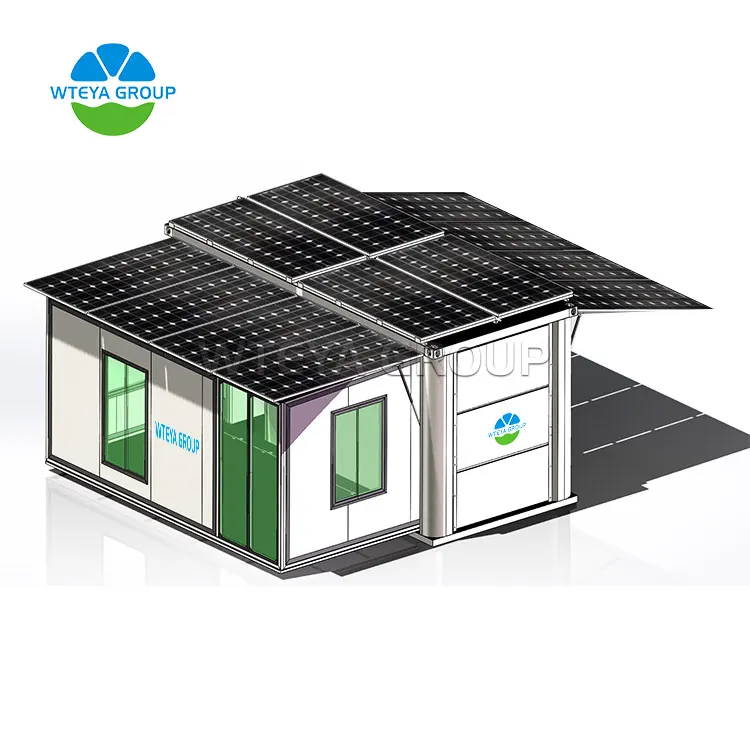Solar Micro-Powered Sewage Treatment Plant
Menu
Latest News
Product introduction
Introduction to Solar Micro-Powered Sewage Treatment Plant
The Solar Micro-Powered Sewage Treatment Plant combines advanced solar photovoltaic power generation technology and sewage treatment technology, aiming to use renewable energy to drive the purification of domestic sewage to achieve efficient use of resources and sustainable development of the environment.
Composition of Solar Micro-Powered Sewage Treatment Plant
The Solar Micro-Powered Sewage Treatment Plant is a multifunctional environmental protection system, and its core components include:
1. Solar photovoltaic panels: As the energy center of the system, photovoltaic panels convert solar energy into electrical energy to meet the energy needs of sewage treatment facilities.
2. Battery pack: Stores the electricity generated by photovoltaic panels to ensure that the system can continue to operate under no light conditions.
3. Control system: Using microcomputer control and remote communication technology, automatically monitor and manage the sewage treatment process, including adjusting aeration time, return flow ratio, and monitoring plant status to achieve energy-saving and efficient operation.
4. Aeration system: Oxygen is injected into the treatment pool through an electric aeration device to promote the activity of aerobic microorganisms and the biodegradation of organic matter.
5. Return system: Through the set ratio, part of the treated water is returned to the front end of the system to maintain the activity of the microbial community and stabilize the treatment efficiency.
6. Biological treatment unit: including anaerobic tanks, aerobic tanks (such as biological contact oxidation tanks) and sedimentation tanks, these units remove pollutants such as organic matter, ammonia nitrogen and nitrite in the water through the metabolism of microorganisms.
7. Filtration unit: such as sand filter or membrane filtration system, further remove suspended matter and some dissolved organic matter in the water to improve the quality of effluent.
8. Disinfection unit: ultraviolet rays, ozone or chemical agents are used for disinfection to kill bacteria and viruses in the water to ensure the safety of effluent.
9. Structural components: including the shell, support structure, pipelines and valves of the plant, usually designed as buried or above-ground type, aiming to save space and improve the beauty of the environment.
10. Safety and monitoring plant: such as level gauges, pressure gauges and water quality monitoring instruments, real-time monitoring of the plant operation status to ensure safety and water quality.
Features of solar micro-powered sewage treatment plant
- Energy-saving and high-efficiency: using solar energy to reduce electricity consumption and reduce operating costs.
- Environmentally friendly: reducing greenhouse gas emissions, avoiding secondary pollution, and complying with the principle of green and low-carbon.
- Automated operation: automatically adjusting the treatment process to minimize human intervention.
- Small footprint and integrated design: easy to install and maintain, suitable for occasions with limited space.
- Convenient maintenance: modular design simplifies filter material replacement and system maintenance.
- Wide adaptability: suitable for domestic sewage treatment needs of various sizes, such as decentralized residences, rural areas, resorts and small towns.
Application areas of solar micro-powered sewage treatment plant
The plant is particularly suitable for areas far away from the power grid and with unstable power supply, as well as communities, residential areas and tourist attractions that pursue green and low-carbon life. It is an ideal solution to solve the problem of domestic sewage treatment in remote areas, and an important technical equipment to promote ecological civilization construction and environmental protection.
Technical principle of
1. Collection and pretreatment: First collect domestic sewage, after simple pretreatment such as grating and precipitation, remove large particles and impurities.
2. Solar power supply: The solar photovoltaic panel built into the system converts solar energy into electricity, which is stored in the battery for the entire sewage treatment system, including mixing, aeration, pumping and other energy-consuming links.
3. Biochemical treatment: The core treatment part usually adopts biological treatment technology, such as activated sludge method, biofilm method (such as MBR membrane bioreactor) or anaerobic-aerobic (A/O) process, which uses microorganisms to decompose organic matter in sewage and remove nutrients such as nitrogen and phosphorus.
4. Deep purification: The water after biochemical treatment is further removed by sand filtration, activated carbon filtration or membrane filtration and other advanced treatment technologies to further remove fine suspended matter and some dissolved organic matter and improve the effluent quality.
5. Disinfection: Finally, pathogens in the water are killed by ultraviolet disinfection, ozone or chemical disinfectants to ensure the safety of the water.
6. Reuse or discharge: The treated water can be directly used for flushing, irrigation and other non-drinking purposes, or discharged to natural water bodies, in line with local environmental discharge standards.
The production process of

1. Pretreatment: Remove large particles and impurities from the water by physical methods such as grating and precipitation.
2. Biochemical treatment: The use of activated sludge method, biofilm method, etc., through microbial action to remove organic matter, nitrogen and phosphorus and other pollutants.
3. Advanced treatment: It may include sand filtration, membrane filtration and other steps to further remove fine suspended matter and some dissolved substances to improve water quality.
4. Disinfection: In the final stage, ultraviolet light or chlorination are usually used to kill bacteria and viruses in the water to ensure the safety of the water.
Production of equipment

Capacity and size
|
Type I (above-ground integrated sewage treatment system) product parameter table |
||||||
|
Model number |
Treated water quantity (m³/d) |
Overall dimension |
Installed power (kw) |
Power supply mode |
||
|
L(m) |
W(m) |
H(m) |
||||
|
WTY-SH-DS-20 |
20 |
7.00 |
2.00 |
2.30 |
2.50 |
Solar energy |
|
WTY-SH-DS-30 |
30 |
7.80 |
2.00 |
2.30 |
2.62 |
Solar energy |
|
WTY-SH-DS-50 |
50 |
10.0 |
2.30 |
2.60 |
3.50 |
Solar energy |
|
WTY-SH-DS-100 |
100 |
20.0 |
2.30 |
2.6 |
7.65 |
Solar energy |
|
Type II (underground integrated sewage treatment system) product parameter table |
||||||
|
Model number |
Treated water quantity (m³/d) |
Overall dimension |
Installed power(kw) |
Power supply mode |
||
|
Φ(m) |
L(m) |
Total height |
||||
|
WTY-SH-DX-20 |
20 |
2.00 |
7.00 |
2.3 |
2.50 |
Solar energy |
|
WTY-SH-DX-30 |
30 |
2.00 |
7.80 |
2.3 |
2.62 |
Solar energy |
|
WTY-SH-DX-50 |
50 |
2.30 |
10.00 |
2.6 |
3.50 |
Solar energy |
|
WTY-SH-DX-100 |
100 |
2.30 |
20.00 |
2.6 |
7.65 |
Solar energy |
Effect drawing

Frequently Asked Questions
1.Solar photovoltaic panel efficiency reduction:
• Cause: stains, occlusions or aging on the surface of the photovoltaic panel.
• Treatment: Clean PV panels regularly, remove occlusions, inspect and replace aging or damaged PV panels.
2. Insufficient battery storage:
• Cause: Battery aging, excessive discharge, or charging system failure.
• Treatment: Check the battery status, charge and discharge maintenance or replace the battery if necessary. Make sure the charge controller is working properly.
3. The aeration system does not work or is inefficient:
• Cause: aeration pump failure, blocked aeration pipe or insufficient solar power supply.
• Treatment: Check whether the aeration pump is working properly, clean up clogged pipelines, and ensure adequate power supply.
4. Control system failure:
• Cause: Circuit failure, sensor failure, or control software problems.
• Treatment: Check line connections, replace damaged sensors, upgrade or restart control system software.
5. The treatment efficiency of biological treatment unit decreases:
• Cause: imbalance of biological flora, excessive influent load or improper proportion of nutrients.
• Treatment: Adjust influent flow and nutrient delivery, and re-culture or supplement biological strains if necessary.
6. Effluent water quality is not up to standard:
• Reasons: inadequate pre-treatment, poor biological treatment, blocked filtration system or failure of disinfection unit.
• Treatment: strengthen pretreatment, adjust biological treatment parameters, clean or replace filter media, and check the working status of disinfection equipment.
7. System leakage:
• Cause: Loose pipe connections, broken or aging seals.
• Treatment: Check and tighten or replace pipe connectors, repair damaged parts, and replace aging seals.
8. Winter operation problems:
• Cause: Low temperature causes the efficiency of photovoltaic panels to decrease, water to freeze or equipment to freeze.
• Treatment: Take anti-freeze measures, such as thermal insulation wrap, add anti-freeze agent, to ensure that the temperature of key components is appropriate.







